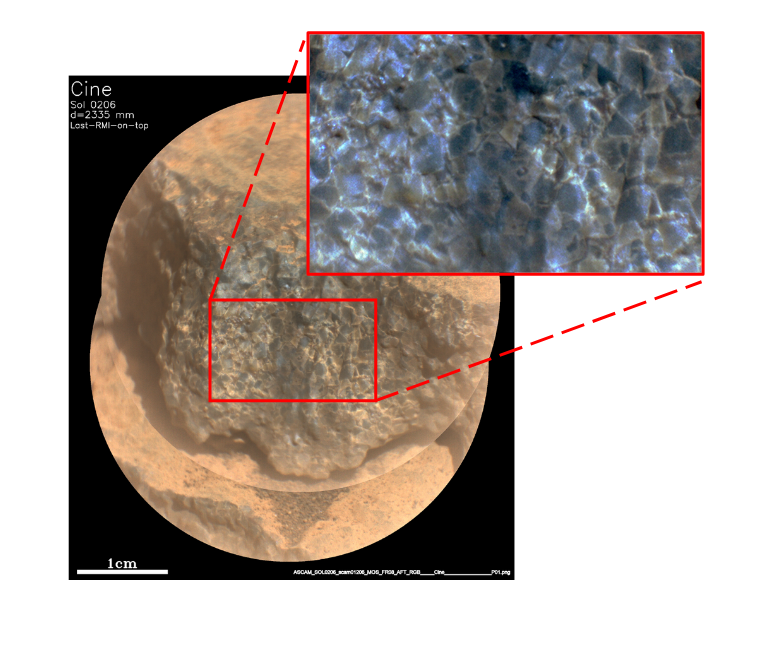Planet Mars: first geological surprises for the Perseverance rover in the Jezero crater
On February 21, 2021, NASA’s Perseverance rover landed on Mars in the Jezero crater. In October (1), the rover confirmed the interest of its landing site: the Jezero crater was indeed home to a lake 3.6 billion years ago. Four publications published on August 25, 2022 in Science and Science Advances report the geological discoveries made by Perseverance in the crater bed.
The first analyses are surprising: the scientists did not observe sedimentary rocks formed by the accumulation of sand and mud that they expected to find in an ancient aquatic environment, but identified instead magmatic rocks derived from deep or surface volcanic processes. Some of these rocks were formed by the accumulation of millimeter-sized grains of olivine, as found in some Martian meteorites. The presence of these gritty rocks on the surface of Mars is surprising. Indeed, on Earth, such rocks are formed at depth in magma chambers by slow cooling of the magma, then are exhumed at the surface by erosion and plate tectonics. Above this unit, rocks of basaltic composition have been identified, probably deposited by later lava flows. Furthermore, the observation of secondary minerals (sulfates, carbonates, perchlorates) testifies to water alteration of all these rocks. Thus, liquid water did circulate after their formation: either during the lacustrine period that allowed the formation of the delta, or during later aqueous flows.
To date 12 rock samples have been collected to be brought back to Earth (2) in 2033. These four publications show that these first samples have a strong scientific potential for geological (magmatism, past magnetic field, geochronology, etc.), geochemical (water and carbon cycles) but also exobiological problems, as this kind of altered rocks is known to provide a suitable niche for Life on Earth and to preserve fossil traces as biosignatures.
The Franco-American instrument Supercam (3) has largely contributed to these discoveries by imaging the texture of the rocks thanks to its very high resolution camera, and by analyzing their chemistry and mineralogy thanks to its various spectrometers. SuperCam has performed more than 1400 analyses that accurately document the geology along the rover’s path and has achieved an unprecedented technological feat by acquiring the first Raman and infrared spectra on the surface of Mars.

In France, this research has been carried out by scientists and engineers from the following laboratories:
- Institut de minéralogie, de physique des matériaux et de cosmochimie (CNRS/Sorbonne Université/Muséum National d’Histoire Naturelle)
- Institut de recherche en astrophysique et planétologie (Université de Toulouse 3 Paul Sabatier/CNRS/CNES)
- Laboratoire d’études spatiales et d’instrumentation en astrophysique (Observatoire de Paris-PSL/CNRS/Sorbonne Université/Université de Paris Cité)
- Laboratoire de planétologie et géosciences (CNRS/Nantes Université/Université Angers),
- Laboratoire de géologie de Lyon : Terre, planètes, environnement (Université de Lyon/Université Claude Bernard Lyon 1/Ecole Normale Supérieure de Lyon/Université Jean Monnet Saint Etienne/CNRS)
- Institut de planétologie et astrophysique de Grenoble (CNRS/Université Grenoble Alpes)
- Centre lasers intenses et applications (CNRS/CEA/Université de Bordeaux)
- Laboratoire atmosphères, milieux, observations spatiales (CNRS/Université Saint-Quentin-en-Yvelines/Université Paris Saclay/Sorbonne Université)
- Institut d’astrophysique spatiale (CNRS/Université Paris-Saclay)
- Institut de mécanique des fluides de Toulouse (Université de Toulouse 3 Paul Sabatier/Institut National Polytechnique de Toulouse)
- Laboratoire d’astrophysique de Bordeaux (Université de Bordeaux)
- Laboratoire GeoRessources (CNRS/Université de Lorraine)
- Centre National d’Etudes Spatiales
- Institut supérieur de l’aéronautique et de l’espace ISAE-SUPAERO (Université de Toulouse)
Notes
- Mangold et al., Perseverance rover reveals an ancient delta-lake system and flood deposits at Jezero crater, Mars, Science, 374, 711, (2021). https://doi.org/10.1126/science.abl4051
- Perseverance is the first mission of the Mars sample return program jointly conducted by NASA and ESA. Its role is to select, document and collect samples to be returned to Earth around 2033.
- SuperCam was developed jointly by LANL (Los Alamos National Laboratory, USA) and a consortium of laboratories attached to CNRS, French universities and research institutions. CNES is responsible to NASA for the French contribution to SuperCam.
Further Resources
- Scientific articles :
- Compositionally and density stratified igneous terrain in Jezero crater, Mars. Wiens et al.,Science Advances, le 25 aout 2022 DOI: 10.1126/sciadv.abo3399
- Aqueously altered igneous rocks sampled on the floor of Jezero crater, Mars. Farley et al., Science, le 25 aout 2022 DOI: 10.1126/science.abo2196
- An olivine cumulate outcrop on the floor of Jezero crater, Mars. Liu et al., Science DOI: 10.1126/science.abo2756
- Ground penetrating radar observations of subsurface structures in the floor of Jezero Crater, Mars. Hamran et al., Science Advances DOI: 10.1126/sciadv.abp8564
- Press Review
IRAP Contacts
- Agnès Cousin, agnes.cousin@irap.omp.eu
- Olivier Forni, olivier.forni@irap.omp.eu
- Sylvestre Maurice, sylvestre.maurice@irap.omp.eu
- Pierre-Yves Meslin, Pierre-Yves.Meslin@irap.omp.eu
- Olivier Gasnault, olivier.gasnault@irap.omp.eu
- Jérémie Lasue, jeremie.lasue@irap.omp.eu
- William Rapin, william.rapin@irap.omp.eu






